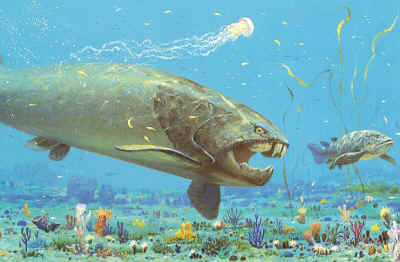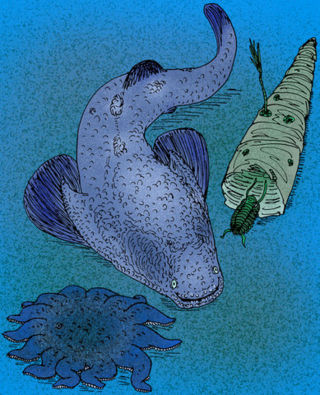 Gnathostomata:
Gnathostomata:| Gnathostomata | ||
| The Vertebrates | Gnathostomata |
| Vertebrates Home | Vertebrate | Vertebrate |
|
Abbreviated Dendrogram
Vertebrata
├─Conodonta
└─┬─Pteraspidomorphi
└─Thelodonti
└─┬─Loganiidae or Osteostraci
└─Gnathostomata
├─┬─Stensioella
│ └─Ramirosuarezia
├─Pseudopetalichthyida
├─Placodermi
└─Acanthodii
├─Chondrichthyes
└─Teleostomi
├─Acanthodii (in part)
└─Osteichthyes
├─Actinopterygii
└─Sarcopterygii
|
Contents
|
Extant Gnathostomata, the clade that includes all jawed vertebrates, including the tetrapods (terrestial vertebrates), divides into the Chondrichthyes - catiligenous fish, sharks, rays, and chimaeras - and the Osteichthyes (vony fish). These latter in turn divide into the Actinopterygii - ray-finned fishes - and the Sarcopterygii - the lobe-finned fishes and the tetrapods. Two once important basal groups are extinct: the Acanthodii, perhaps the sister group of the osteichthyans, and the Placodermi, who may be the sister group to all other gnathostomes.
The non-gnathostome craniates are traditionally refered to as the Agnatha (from the Greek for "jawless"), but as this is a paraphyletic group it is increasingly abandoned as a formal taxon. Andreas091119
from Ordovician or Early Silurian
Thelodonti ::: Loganiidae or Osteostraci + *: Placodermi + Eugnathostomata.
$ A vertically biting jaw which is primitively made up of two endoskeletal elements, the palatoquadrate and Meckelian cartilage, and a number of dermal teeth; paired nasal sacs isolated from the hypophysial tube; spiracle, gill rakers, gill arches internal to gills; 3 semi-circular canals; a branchial skeleton unfused to the neurocranium; $ vertebrae with interventrals and basiventrals (elements lying under the notochord which correspond to the basidorsals and interdorsals respectively); vertebrae with centra, complete cartilaginous skeleton, division (horizontal septum) between dorsal and ventral muscle blocks; paired pectoral fins universal; paired pelvic fins; axons with myelin sheathes.
Note: Jaws may be derived from a primitive first "mandibular") gill arch and/or from the bone supporting the velum. See Meckel's Cartilage, where this contentious issue is hashed out at great length. One problem with either derivation is that jawless forms have endodermal gill filaments internal to branchial arches, while gnathostomes have ectodermal filaments external to the arches. It is generally assumed that ancestral forms had dual pouches, as in larval lampreys. Regarding the nasal sacs: in jawless craniates, the nasal sacs open into a median nasohypophysial duct, which also takes part in the formation of the pituitary gland. This duct either leads posteriorly to the pharynx, as in hagfish and galeaspids, or ends as a blind pouch, as in lampreys and osteostracans. In gnathostomes, the duct or pouch forms a thin buccohypophysial canal in the palate, while the nasal sacs open separately to the exterior by external nares.
Gnathostomata Tree of Life); Gnathostomata; Phylogeny of Gnathostomata; Gnathostomata; Bio-DiTRL; Kiefertiere; Gnathostomata; Phylogeny of Gnathostomata; Gnathostomata; Gnathostomata; Phylogenetic Studies of Complete Mitochondrial DNA Molecules ...; Gnathostomata; -- Algosobre Vestibular --.
ATW030917.
Range: Latest Pragian/Early Emsian (Early Devonian) of Germany (Hunsrück slates).
Phylogeny: stem Gnathostomata, may or may not be related to Ramirosuarezia.
 The basal Gnathostome Stensioella heintzi. Here, one of the beasts is settling down with the starfish Helianthaster rhenanus, while a Phacops ferdinandi trilobite explores a forgotten orthocone nautiloid shell. Art and caption , Stanton060928 Reconstruction - Deviant Art |
Comments: Stensioella heintzi is an enigmatic fish of arcane affinity. It is known from the Lower Devonian Hunsrück slates of Germany, where the only specimens have been found.
In life, it was a blocky-looking fish that resembled either a squat, pug-nosed combination chimaera-stargazer, or an uncompressed Gemuendina (Gemuendina also happened to be its contempary in Hunsrück). Like Gemuendina, it had armor made up of a complex mosaic of tubercles.
It has often been long regarded as a primitive placoderm (Gross 1962; Stensiö 1969; Denison 1978), as from what can be discerned from the few whole specimens found, the shoulder joints of its armor appear to be very similar to other placoderms. However, aside from this, coupled with superficial similarities in skull plates, and gross, superficial similarities between its tubercles, and the tubercles of the rhenanids, there are very few concrete reasons for S. heintzi's placement in Placodermi. Another hypothesis, proposed by Philippe Janvier and others, is as a possible stem holocephalan. This implies that holocephalids (chimaeras, iniopterygians, petalodonts, et al) diverged from sharks before the Chondrichthyan Carboniferous radiation. But aside from a similar bodyplan to primitive holocephalids like Menaspis, there is very little else in common with S. heintzi and holocephalids. The recent discovery of the enigmatic Gondwanan taxon Ramirosuarezia boliviana raises a third, perhaps more persuasive, possibility; that Stensioella belongs to an assemblage of stem gnathostomes that cannot be easily placed in any of the established clades. Stanton060925, the Palaeos wiki/Wikipedia, MAK111025
Eifelian (Early Devonian) Icla Formation of Bolivia.
Phylogeny: stem Gnathostomata.
Comments: Ramirosuarezia is a genus of prehistoric jawed fish that lived during the Eifelian stage of the Early Devonian. It is based on a single articulated skull from the Icla Formation of Bolivia. The braincase of the genus bears a resemblance to those of elasmobranchs, however other features are not entirely diagnostic of a placement in Elasmobranchii or Chondrichthyes. The "tooth-bearing 'labial' elements", however, seem to have certain similarities to stem-holocephalans. The endoskeleton is not made up of endochondral bone, but instead perichondral bone or non-prismatic calcified cartilage. Although devoid of large dermal bones and scales, R. boliviana shares with certain "ostracoderms", placoderms and holocephalans the lack of an otico-occipital fissure, but lacks a hypophysial fenestra. Other features of the holotype, such as an elongated braincase, 'labial elements', the presence of dermal denticles and teeth, suggest a relationship with the stensioellids, which were once though to have been primitive placoderms or stem holocephalans. Aside from these, no character supports the affinities of Ramirosuarezia with any certainty to any of the currently known major gnathostome groups. It is possibly related to the fossil genus Zamponiopteron, which is known from calcified 'fin plates' and isolated shoulder girdles, and is also from the Eifelian of Bolivia. (Pradeletal2009) Fossil Wiki, slightly modified (Attribution-ShareAlike license)
Pseudopetalichthyida: Pseudopetalichthys problematica, Paraplesiobatis heinrichsi, Nessariostoma granulosa
Latest Pragian/Early Emsian (Early Devonian of Hunsrück, Germany.
Phylogeny: stem Gnathostomata
Comments: Yet another group of enigmatic Devonian proto-fish, traditionally placed among the placoderms because there's nowhere else to put them. We've moved them to the basal gnathostomes, pending future phylogenetic analyses. MAK111025
The Pseudopetalichthyida is a group of extinct, skate-like fishes known only from rare fossils in Lower Devonian strata in Hunsrück, Germany. Like Stensioella heintzi and the Rhenanida, the pseudopetalichthyids had armor made up of a mosaic of tubercles. And as with Stensioella heintzi, the pseudopetalichthyids' placement within Placodermi is suspect, although those who do regard them as placoderms place them in a more or less basal (bit not totally basal) position (see Placoderm phylogeny for various phylogenies)
The best known, and aptly named species is Pseudopetalicthys problematica. Some experts have suggested that Paraplesiobatis heinrichsi is the same species as P. problematica, but, due to the specimens of the latter species being crushed in a different position than the specimen of the former species, the anatomies of the two forms appear different (Moy-Thomas & Miles). However, this problem will be resolved only with more specimens. The anatomy of the specimens of Nessariostoma granulosa are sufficiently different from the other two pseudopetalichthyids to be recognized as a separate species. Nessariostoma granulosa bears a superficial resemblence to Stensioella heintzi, and it was this resemblence that originally lead to the pseudopetalichthyids' grouping within Stensioellidae. Stanton061016, slightly revised MAK111025
Checked ATW060126, new page MAK111025